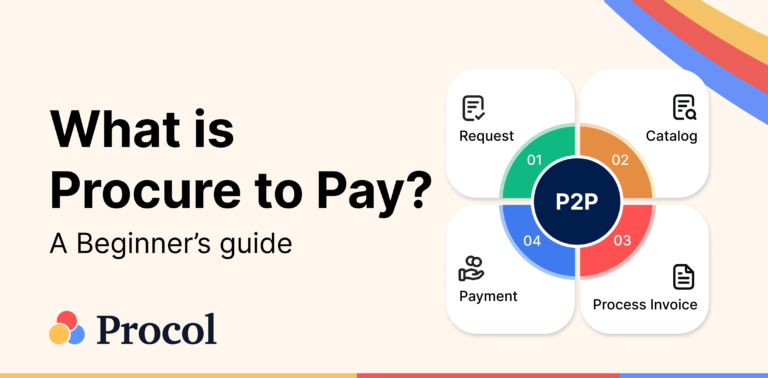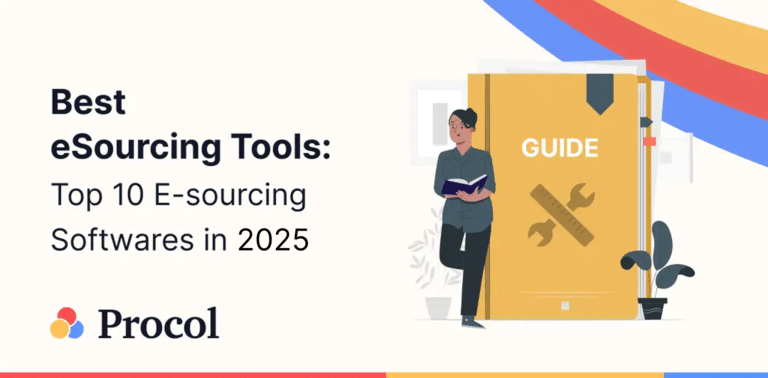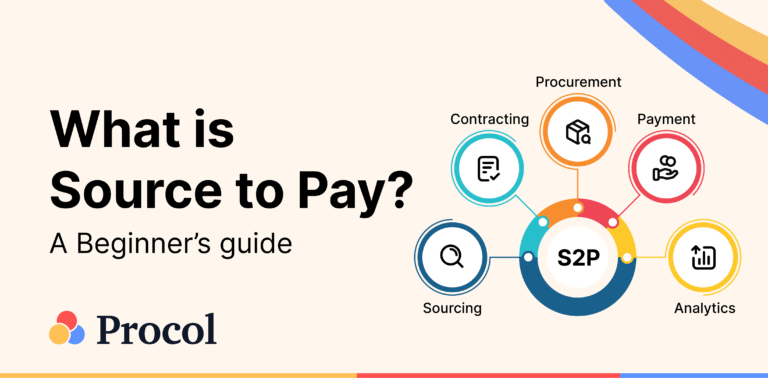Procol • April 15, 2025
Procurement Negotiation Guide: Process, Benefits, and Tips

Introduction
Negotiation is a powerful and effective skill that ensures satisfaction and fulfilment of your needs. It is not only related to price; it can also be done over terms and conditions, particular quality and quantity of products, services, etc. Negotiation is commonly practised in the business world to achieve goals, as it is useful in cost savings, enhancing reputation, securing better deals, and creating value.
Negotiation is also practised in the procurement sector to improve supply chain efficiency; for long-term savings, better deals, consistent quality, compliance, and streamlined processes, negotiations have always been the effective way to ensure goal achievement.
However, conducting negotiations effectively is a skill; if utilized properly, it often gives a business an advantage. But what is procurement negotiation? What are negotiation techniques? Let’s learn in detail.
What is negotiation in procurement?
Negotiation in procurement is the most important process in which buyer and vendor come together to Negotiate and draft a deal that complies with everyone. Negotiation involves parties agreeing on the same thing to ensure smooth and satisfied work. Generally, procurement negotiation’s key objectives are reduced cost, quality of products or services, agreement on favourable terms, and relationship management with vendors.
Analytical thinking, solution-oriented approach, clear communication, persuasion, negotiation tactics, and emotional intelligence are some of the necessary skills vital to successful procurement negotiations.
Companies decide to perform procurement negotiation for various reasons, such as needing timely deliveries, premium-quality raw materials, and intellectual property rights.
What are the seven stages of negotiation in procurement?
To carry out negotiation in procurement effectively there are mainly 7 stages of negotiation in procurement that eases procurement negotiation processes.
1. Preparation
The primary steps of negotiation in procurement are:
- Preparation.
- Defining goals and objectives.
- Jotting down essential information.
- Doing market research to collect information about the latest trends and market conditions.
- Outlining a clear strategy to achieve desired goals is part of preparation.
Preparation gives clarity for long-term work, acting as a foundation.
2. Opening
After preparation, the most crucial step starts the opening of the negotiation. For procurement negotiation, professionals gather together, and both parties put the purpose and objectives behind the negotiation, outline guidelines for the process, and have an agenda for the meeting to bring everyone on the same page. It is important to listen to others, but it is also recommended that you address any issues or objections brought forward by another side and state your objectives.
3. Testing
This third stage of the negotiation process in procurement requires better communication skills, which are important for gaining real insights. It includes understanding vendors’ ideas, competencies, and limits. It is crucial to clarify your purpose and expectations and ask every question to understand vendors’ strengths, capacity, standards, and cost structure and to understand what they can offer.
4. Proposing
In this stage, both parties keep their proposals and have the right to negotiate and present counteroffers. Check whether vendors’ offers include what you want, and present your proposal in a structured way, including all data points and analysis. Be flexible, listen, and handle counter offers effectively.
5. Bargaining
This is where the actual negotiation process begins; after hearing each other’s proposals, both parties argue, negotiate, and compromise in some terms if they are willing to close the deal. Clear any doubts, use trade-offs, and make concessions if needed. Consider concessions from the supplier as well.
6. Agreement
If the deal is meant to be closed, then after all the above stages, the agreement part comes, where a legal agreement is made to bind parties to their commitment. There should be no room for misunderstanding; the contract must include all agreed-upon terms.
7. Closure
Closure is the stage of finalizing an agreement. Last time, the parties reviewed the agreement carefully, clarified the terms, drafted the contract, and finally, if both were willing to close the deal, signed off legally. Assigning roles, initial check-in, and monitoring happen after closure.
What are the various procurement negotiation techniques?
Effective negotiation techniques in procurement are crucial for achieving the best possible deal aligning with your business objective. These are the top 5 negotiation techniques in procurement.
1. Reinforce fear as excitement
The negotiation process in procurement has many layers, and thinking about all those processes can create a feeling of anxiety in a person; anxiety can happen to even professionals with years of experience, which leads to squeaky voices and sweating, which overall creates a bad impression and may even create barriers in conducting a successful negotiation. But it can be dealt with by considering interpreting the high level of physiological response that is connected to anxiety as excitement. This point of view, treating nervousness of the unknown with excitement, can be useful in successful procurement negotiation.
2. Use a written agreement as the discussion’s main topic
The second negotiation technique is procurement, where it’s suggested to have a written agreement with yourself, mentioning all important points such as objectives, goals, expectations, and terms. It has been found that those who initiate negotiations have a higher chance of success. Present the draft as a starting point. Such draft agreements are useful in driving the process in the direction you intended and in negotiating effectively.
3. Make use of silence’s power
Often, there is a chance to make a mistake to avoid the awkwardness of silence or being in a rush. Taking a pause, a moment of silence after the opposite party’s speech, allows you to analyze and understand their point and come up with a more accurate thing to come up with. Also, a silent moment after keeping your points gives a chance for the next party to understand your points and wait for them to respond. During tough negotiations and disagreements, this negotiation technique is a procurement that gives time to respond.
4. Request guidance
Ask for guidance from the opposite party if you need it. It’s one of the most effective ways. One party approaches another party for guidance to understand their needs and points of view better. Ask clear, forward questions where you might feel doubtful, get clarification, ask for feedback, and learn their viewpoints on your offers and terms. Ask about the best strategy or practice of the industry they might know to yield better results.
5. Use final-offer disputes to evaluate an acceptable deal
After constant negotiation and disputes to finally agree on some terms, procurement negotiation reaches the endpoint where the parties offer a final offer, and in this case, there is no option for further negotiation. In your final offer, mention the best possible terms. Evaluate the offer. This is the stage where parties have a choice to either accept or reject the offer.
What are the seven rules of negotiation?
1. Clearly defined, achievable goals
Defining goals is the essential step for negotiation in procurement; building specific and realistic goals and prioritizing critical goals are things to be primarily focused on. Goals should be in alignment with objectives that the company is willing to meet, whether in terms of quality, cost, or anything; it must add value to the supply chain processes. This builds the foundation for further negotiation in procurement. In defining goals, stakeholders are involved, and expertise is sought from them. Decide on what basis success will be calculated by fixing some key performance indicators (KPIs). With negotiation, businesses can find a way to refine goals if needed.
2. Create your strategy
Having a predefined strategy to guide procurement negotiation always works in your favor. In most negotiations, compromise and trade-offs are necessary, so keeping this in mind and having predefined clarity on what terms you can settle down for and for which there is no way to think twice. Having a thoughtful strategy in place increases your credibility and confidence when negotiating.
3. Investigate the opposition
One must be aware of with whom they are going to negotiate and know their strengths, past work, and other essential criteria. Grounds include work quality, behaviour, and reputation, as well as attention in the market. It is crucial to know vendors and possible expectations, and it is crucial to know stakeholders from the vendors.
4. Gain-gain
The main reason behind the negotiation process in procurement is to grab the deal covering all terms and benefiting the business. However, remember that winning should be achieved for both the supplier and the buyer to maintain a long-term relationship based on trust. This approach provides a winning opportunity for both parties.
5. Engaging in active listening
To lead procurement negotiation effectively, understanding vendors’ concepts and perspectives and reacting accordingly are essential. Through your words and body language, ensure that you actively listen to them, don’t make any assumptions from your end, clarify things if there is any doubt, and think from their perspective.
6. Establish trust
Trust is the most important factor in establishing any deal. Build an environment of trust and credibility, be honest about objectives and expectations, and be transparent. Transparency and honesty avoid misunderstanding and maintain moral standards to gain the other party’s trust. Even in case of any disagreements, try to understand their perspective and concerns.
7. Value-focused
Cost reduction benefits through negotiations are one of the aspects, but solely focusing on price and neglecting the value offered makes no sense. Get insights about the quality of products or services offered by vendors, and measure the innovation, manufacturing, and continuous improvement expertise of vendors.
Top negotiation tips for success
Having clarity about objectives behind procurement and negotiation is a must, one of its Important aspects is streamlined communication, which is important to avoid misunderstanding. This can be done via sharing documents, and feedback and keeping track of it use it in case of any future dispute.
It is important to explore different offerings from different vendors to grab the best deal for business. Many times, vendors are aware of such things, but keeping the identity of vendors confidential from others is important because they might be familiar with another vendor, which can create barriers to transparent and effective procurement negotiation.
It has been found that negotiations made near the end of the month, quarter, or year are most cost-effective because salespeople offer great discounts during this period. Consider whether you are flexible enough to wait until this period and ensure it doesn’t cause you any loss in other terms.
Maintain professionalism throughout the process and communicate respectfully. Such behaviour can create willingness in suppliers to consider your offering and might show interest in communicating to close the deal.
Five major strategies for negotiation
For successful procurement negotiation, procurement negotiation strategies are essential, which ensure the achievement of optimal conditions. Here are the top 5 negotiation strategies in procurement –
1. Effective talks don’t always begin with nothing
Instead of communicating all from scratch, it is better to discuss previous work, its achievements and problems they have dealt with, and what kind of solutions they provided. Precisely ask questions about problems you think you might encounter in the future, and ask if you have dealt with such situations before.
2. Power is dependent on what the provider values
It is recommended that you gather some information about the vendor you are dealing with, including vendor objectives and values. Based on such knowledge, you can create a strategy and lead negotiation in that direction, working in your favour by addressing those needs and values. This is an effective negotiation strategy in procurement.
3. Keep an eye out for commercial factors
This is one of the essential procurement negotiation strategies. It is important to keep an eye on commercial factors that impact procurement. It is not just about the price; commercial factors like quality of product or service, total cost of ownership, contract terms and conditions, etc.
4. Agree to terms of a contract based on results
This negotiation strategy in procurement talks about connecting payments, rewards or any penalties based on results yield, it results-based. To apply it effectively, define KPIs to measure results and make vendors accountable.
5. The best alternative for a negotiated agreement
If the deal doesn’t close, then it is better to have another alternative like sourcing from another vendor, analyzing cost, product quality, and other factors. This is a must-follow strategy in procurement negotiation strategies, having the best alternative ensures you are not settling for any worse deal than you expected.
What are the advantages of negotiation in procurement?
It is clear that the negotiation process in procurement happens to close the deal, which aligns with your terms, values, objectives, and goals, but to be precise, procurement negotiation has some highlighting features. Clear communication leaves no place for misunderstanding, builds relationships with the right vendors, reduces the possibility of any future conflict, gives the advantage of having profitable agreements, reduces cost, and improves quality by maintaining legal agreements.
How do you handle negotiations successfully?
Effective and strategic negotiation in procurement can give the best deals to businesses, it all starts with being clear about your goals and terms. Conducting market analysis, and gathering data about ground and past projects, in all those things, communicating plays an essential role in maintaining professionalism, and a polite tone can bend negotiation in your favour. Negotiation may not turn into an agreement, so having the best alternative ensures you don’t have to settle for anything less. Be open to clear and transparent communication.
Conclusion
Negotiation in procurement is a must to grab your ideal deal. There are seven essential steps to carry out effectively: preparation, opening, testing, proposing, bargaining agreement, and closure. Each stage holds its importance. To make sure you win, there are some negotiation techniques in procurement covering aspects of effective negotiation, reinforcing fear as excitement, using a written agreement as the discussion’s topic, making use of silence’s power, requesting guidance, and using final-offer disputes to evaluate an acceptable deal are negotiation techniques in procurement.
Having defined rules gives direction to successful meetings; there are precisely seven rules of negotiation: Clearly defined, achievable goals, creating your strategy, investigating the opposition, gaining gain, engaging in active listening, establishing trust, and being value-focused are those rules. Impactful negotiation strategies in procurement make the negotiation successful, which has also been discussed.
Explore more from Procol
Discover expert tips, how-to guides, industry insights, and the latest procurement trends.

What is Procure-to-pay (P2P)? An Ultimate Guide
Procure to pay is the process from procurement of materials needed...

Best eSourcing Tools: Top 10 eSourcing Software in 2025
Discover top 10 e-sourcing tools and esourcing platforms necessary for efficient...

What is Source-to-pay in 2025? An Ultimate Guide
Source to pay is the process of sourcing vendors to procure...











